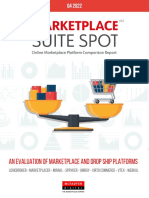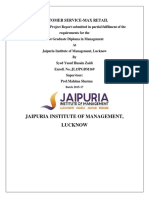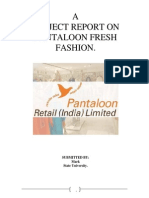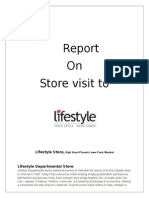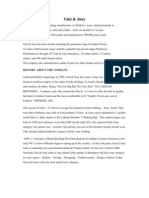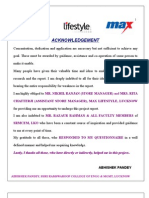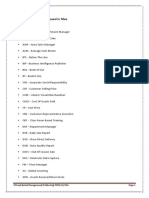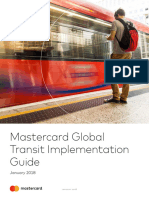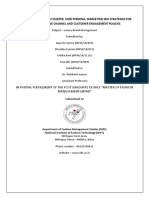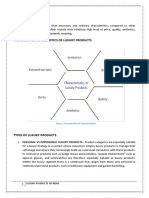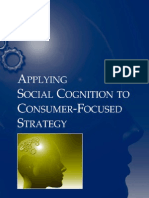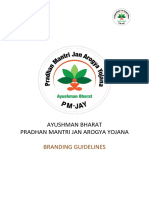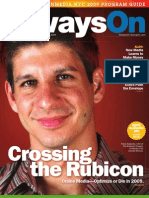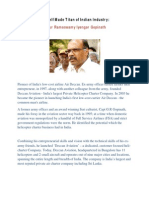Landmark
Landmark
Uploaded by
Tulika RajCopyright:
Available Formats
Landmark
Landmark
Uploaded by
Tulika RajOriginal Description:
Original Title
Copyright
Available Formats
Share this document
Did you find this document useful?
Is this content inappropriate?
Copyright:
Available Formats
Landmark
Landmark
Uploaded by
Tulika RajCopyright:
Available Formats
Page 1 of 55
ABBREVIATIONS
ACM - Average Cash Memo
ADM – Assistant Department Manager
AIC - Alternative Item Code
ASM – Area Sales Manager
ATL - Above The Line
BIP - Business Intelligence Publisher
BOL - Book Of List
BS - Basket Size
BTL - Below The Line
CBT - Class Room Based Training
COGS - Cost Of Goods Sold
CP - Cost Price
CRE – Customer Representative Executive
CRM- Chrome
CSP - Customer Selling Price
CSR - Corporate Social Responsibility
CVM – Cluster Visual Merchandiser
DM – Department Manager
DQR - Data Quality Report
DSD - Store Direct Delivery
DSR - Daily Sale Report
EDC – Electronic Data Capture
EOSS – End Of Season Sale
FM – Floor Manager
GC - Global Counting
VM and Retail Management| Saurabh| MFM 2018-20
Page 2 of 55
GIT - Goods In Transit
GP - Returnable Gate Pass
GRA – Goods Receive Note
GRN - Goods Receive/Return Note
GTM – Go To Market
GV - Gift Voucher
HR – Human Resource
IST - In Store Trainer
LFL - Last For Last
LIFE - Landmark International Of Empowerment
LMR - Landmark Reward
LMS – Learning Management System
LOB – Last Of Best
MAP - Moving Average Price
MGD – Meet Greet and Direct
NOOS – Never Out of Stock
NTG – Non-trade goods
OJT - On Job Training
PDT – Portable Data Machine
PI - Perpetual Inventory
PO – Purchase Order
POE – Power Over Ethernet
POP - Point Of Purchase
POS - Point Of Sale
RMS - Returnable Merchandise Sub code
ROS - Rate Of Sale
VM and Retail Management| Saurabh| MFM 2018-20
Page 3 of 55
RTV - Return To Vendor
RVM - Regional Visual Merchandiser
SAD - System/Stock Adjustment
SIM - Stock Inventory Module
SM – Store Manager
SOP – Standard Operating Procedure
STN – Stock Transfer Number
STR - Sale Through Rate
PD - Sale Per Day
TT - Training Transformation
TTT - Training The Trainer
VM - Visual Merchandiser
VNC – Virtual Network Graphic
WBC - Without Barcode
VM and Retail Management| Saurabh| MFM 2018-20
Page 4 of 55
TABLE OF CONTENT
1. About the Landmark group……………………………………………………………………………….........7
2. About Max Fashion……………………………………………………………………………………………........8
3. Retail Management……………………………………………………………………………………………......11
4. Concessionaire brands...............................................................................................13
5. Hierarchy of Max Fashion…………………………………………………………………………………........14
6. Marketing strategies…………………………………………………………………………………………........15
7. Selling Tactics……………………………………………………………………………………………….............17
8. Sale report………………………………………………………………………………………………………….......17
9. Petty cash management……………………………………………………………………………………….....18
10.Sourcing……………………………………………………………………………………………………………….....19
11. Inventory and Logistics………………………………………………………………………………………......19
12. Commercial process…………………………………………………………………………………………….....19
13. DSR………………………………………………………………………………………………………………………....22
14.IT in retailing………………………………………………………………………………………………………......24
15.POS process……………………………………………………………………………………………………………..26
16.Exchange policy…………………………………………………………………………………………………….....27
17.Incentive plan……………………………………………………………………………………………………….....28
18.Manpower recruitment and training……………………………………………………………………......29
19.EOSS season launch.....................................................................................................31
20.Pre-autumn launch......................................................................................................32
21.Omni-channel………………………………………………………………………………………………………......33
22.Category management…………………………………………………………………………………………......34
23.Visual Merchandising…………………………………………………………………………………………........36
24.Types of Fixture, Signage and communication……………………………………………………........38
25.Windows of Max………………………………………………………………………………………………….......43
26.SWOT analysis……………………………………………………………………………………………………........49
27.Suggestions………………………………………………………………………………………………………….......50
28.Conclusion………………………………………………………………………………………………………….........51
29.References..……………………………………………………………………………………………………….........52
VM and Retail Management| Saurabh| MFM 2018-20
Page 5 of 55
TABLE OF IMAGES
1. Figure 1............................................................................Logo of Landmark Group
2. Figure 2.......................................................................................Logo of LIFE Trust
3. Figure 3...............................................................................................Logo of Max
4. Figure 4............................................................................................People at Max
5. Figure 5................................................................................Logo of Peter England
6. Figure 6............................................................................................Logo of Kappa
7. Figure 7...........................................................................................Logo of Aurelia
8. Figure 8...............................................................................Logo of Flying Machine
9. Figure 9......................................................................................Logo of Oxemberg
10. Figure 10.........................................................................................Logo of Jockey
11. Figure 11..........................................................................................Logo of Turtle
12. Figure 12.............................................................................Sensomotoric Machine
13. Figure 13......................................................................Foot Fall counting machine
14. Figure 14.......................................................................Logo of Landmark rewards
15. Figure 15......................................................................Form of Landmark rewards
16. Figure 16.............................................................................Slip of Invoice Logistics
17. Figure 17........................................................................................Received stocks
18. Figure 18...................................................................................Weighing Machine
19. Figure 19............................................................................................PDT machine
20. Figure 20..........................................................................................Logo of Oracle
21. Figure 21............................................................................................................Bill
22. Figure 22...........................................................................................Exchange slip
23. Figure 23......................................................................................Store credit note
24. Figure 24..........................................................................................Incentive Plan
25. Figure 25...........................................................................................EOSS window
26. Figure 26................................................................................Pre-autumn window
27. Figure 27...........................................................................................Folding Table
28. Figure 28..............................................................................................A-rail Table
29. Figure 29..................................................................................Double-Sided Table
30. Figure 30....................................................................................................Browser
31. Figure 31...........................................................................................Nesting Table
32. Figure 32...................................................................................................Slat wall
33. Figure 33................................................................................................Mesh wall
34. Figure 34.........................................................................................Sunglass tower
35. Figure 35.......................................................................................Queue Manager
36. Figure 36...................................................................................................Gondola
37. Figure 37.............................................................................................Denim Table
38. Figure 38........................................................................................Folding Signage
39. Figure 39............................................................................................Price Signage
VM and Retail Management| Saurabh| MFM 2018-20
Page 6 of 55
40. Figure 40...........................................................................................Lectern Signage
41. Figure 41................................................................................................Sale Signage
42. Figure 42................................................................................................Video Panel
43. Figure 43........................................................................................................Signage
44. Figure 44........................................................................................................Pointer
45. Figure 45...................................................................................................High Point
46. Figure 46...........................................................................................................T-bar
47. Figure 47.....................................................................................................Peg hook
48. Figure 48...........................................................................................................U-bar
49. Figure 49......................................................................................................Back bar
50. Figure 50................................................................................................Straight arm
51. Figure 51.....................................................................................................Step arm
52. Figure 52.........................................................................................Primary Window
53. Figure 53.....................................................................................Secondary Window
54. Figure 54..........................................................................................Cluster Window
55. Figure 55....................................................................................Open-back Window
56. Figure 56.................................................................................Elements of a Window
57. Figure 57.................................................................................Elements of a Window
58. Figure 58.................................................................................Elements of a Window
59. Figure 59.......................................................................................White Mannequin
60. Figure 60.........................................................................................Grey Mannequin
VM and Retail Management| Saurabh| MFM 2018-20
Page 7 of 55
LANDMARK GROUP
It was founded in 1973 with a single store in Bahrain by Micky Jagtiani.
The Landmark Group has successfully grown into one of the largest and
most successful retail industry in the Middle East, Africa, and India. The
Landmark Group has over 55,000 employees and operates over 2,200
outlets and occupies over 30 million sq. ft. across 21 countries which
includes India, Dubai, Kuwait, Malaysia, Indonesia, etc. The Group has
also diversified into leisure, food, hotels, and electronics and has created Figure 1 Logo of Landmark group
a comprehensive infrastructure including its logistics and distribution
division to support its retail operations and other businesses.
The Group provides a value-driven product range for the entire family through a diverse portfolio of
57 brands by constituting 27 own brands and 30 franchise brands.
Overview –
Over 44 years of retail experience
Over 55,000 employees.
Presence across the Middle East, Africa, and the Indian subcontinent.
Over 2,200 outlets and 30 million sq. ft. retail space
27 own brands and 30 franchise
BUSINESS AND BRANDS
Landmark Group's business can be broadly classified into Retail, Hospitality, and Healthcare.
Babyshop, Splash, Max, Lifestyle, Iconic and Centrepoint (a single store format
Apparel housing Babyshop, Splash, Shoemart, and Lifestyle) and International Fashion
Franchises (Lipsy, Koton, New Look, Reiss & Yours London), Easybuy (Fashion)
Footwear Shoemart, Shoexpress, Shoemart International Footwear
Furniture & Home
Home Centre & Home Box
Improvement
Citymax, Oasis Malls, Foodmark, Spaces, Fitness First, Fun City, Fun Works, and
Hospitality
associated trademarks
Healthcare iCare Clinics, Balance Wellness Club
Others retail E-max (Consumer Electronics), Sports One (Fitness Gear), Candelite
VM and Retail Management| Saurabh| MFM 2018-20
Page 8 of 55
In 1999, the Landmark Group entered India to revolutionize retailing in the country by launching its
first Lifestyle store in Chennai. The group now operates more than 350 stores in India and
employees more than 15,000 people. It is known as a youth brand because it offers a trendy,
youthful and vibrant brand that offers customers a wide variety of merchandise at an exceptional
value for money. After doing 20 years of retailing in India, Landmark Group has launched several of
its core retail brands in the country which includes Home Centre, Splash and Max Fashion.
LOGISTICS AND DISTRIBUTION STRENGTH
Landmark Group has created a comprehensive infrastructure including a full-fledged logistics and
distribution division to support its retail operations. The Group has a total warehouse space of over
9.3 million sq. ft. The Group’s Logistics and Re-distribution centre is one of the largest privately
owned in the Jebel Ali Free Zone, Dubai encompassing 3.1 million sq. ft.
CORPORATE SOCIAL RESPONSIBILITY
The Landmark Group also seeks opportunities to contribute to the communities where it operates.
Its commitment to Corporate Social Responsibility (CSR) is not merely about charity, but also about
playing a more responsible part in the society, be it within the
organization or towards its stakeholders (customers, partners, and
employees), the environment, society and the world at large. In
2009, the Landmark Group adopted diabetes awareness as part of
its long term CSR initiative. Launched in the UAE, The Beat Diabetes
program aims to increase awareness amongst people regarding the Figure 2 Logo of LIFE trust
condition. Today the programme runs in seven countries including
UAE, Kuwait, Oman, Qatar, India, etc and reaches out to over 20 million people annually through
events and educational initiatives.
In India, the Group’s Chairman, Micky Jagtiani initiated the LIFE Trust program (Landmark
International Foundation for Empowerment) in 2000. LIFE focuses on rehabilitating the less
fortunate through various programs and initiatives such as delivering non-formal education in rural
areas, setting up health centres in urban slums as well as training centres for the underprivileged
youth and imparting life skills training. (Landmarkgroup, 2019)
MAX FASHION
Max Fashion is a fashion brand under the banner of the Dubai based Landmark Group which was
launched in May 2004 in Abu Dhabi. Max has 400 stores across 19
countries. It is the largest fashion brand in the Middle East, North
Africa, South East Asia, and India. Max has its own private-label
clothing for men, women, and children along with footwear, home Figure 3 Logo of Max
and accessories, and sees an average footfall of over 100,000
customers every day.
VM and Retail Management| Saurabh| MFM 2018-20
Page 9 of 55
In India, its first store was opened in Indore in the year 2006. It is a division of Lifestyle brand. Max
has more than 200 stores across 80 cities and it is a mono-brand with its label merchandise that is
created by in-house designers in every season and is currently growing at a 35% CAGR year on year.
It offers apparel, footwear & accessories that are of the latest fashion trends at a great price,
making it affordable to many. It has the concept of ‘value fashion’ in the country because it offers
the shopper a vast choice with international fashion & quality. The brand adapts to the changing
needs of the shopper every season and accordingly introduces new designs. (MaxFashion, 2019)
VISION
To create a truly global brand that provides growth opportunities for the company and its
employees, while achieving its goal of becoming the number one value fashion retailer across the
Middle East and India.
MISSION
Be a market leader in the field of retailing.
Provide fashionable products at affordable prices.
Be innovative, cost-effective and globally competitive.
Exceed our customer’s expectations.
Provide opportunities for growth for our employees.
VALUES
Passion for excellence
Integrity in everything we do
Empowering people to strive and deliver
Adapting to changing market and customer needs
AWARDS
Max won the “Value Fashion Retailer of the year” at the Star Retailer Awards for excellence in
retailing in 2014.
Max won “Images Most Admired Fashion Retailer of the Year 2015” at the Image Retail
Awards.
Max won the “Brand Excellence in the Retail Sector” at the Asian Awards in 2015.
Max won "Asia's most promising brand" in Bangkok by WCRC- World Consulting and Research
Corporation in 2016.
Max (India) won the "Best Loyalty Program" at the Images Retail Awards September in 2017.
Max (India) won the “Fashion Retailer of the year” at the Franchisee India Star Retailer awards
held in Delhi on November 2017.
VM and Retail Management| Saurabh| MFM 2018-20
Page 10 of 55
TARGET AUDIENCE
This brand mainly targets the youth, teenagers and
middle-class families. This brand gives trendy and
youthful collection at a very affordable price. Thus
mostly college-going students and working people
prefer to buy from here.
COMPETITORS
Pantaloons
Reliance Trends Figure 4 People at Max Fashion
Westside
MAX FASHION, PATNA
There are three stores of Max Fashion in Patna –
1. Max Fashion, Western Mall – establishment date is 28th October 2018.
2. Max Fashion, Patna One Mall – establishment date is 4th March 2017.
3. Max Fashion, Pushpanjali Complex – establishment date is 28th July 2018.
ABOUT MAX FASHION, WESTERN MALL
This store was established on 28th October 2018. Mr. Ratnesh Kumar Singh is the Store Manager.
The store has two floors. The 1st floor has Menswear and Womens western wear collection and 2nd
floor have kids and women's ethnic wear collection. There are 20 workers in the store. Each
department has 3 to 4 staffs. At the entrance gate, the store has two security guards one male and
one female who greets the customer and offers shopping bag to them
Store address and timing - Opposite RPS more Bailey Road, Patna, Bihar – 801503. Monday to
Sunday from 11:00 am to 9:30 pm.
STORE CONCEPT OF MAX
Wannabe store Spotlight store Maharatna store
(Per day sale should be (Per day sale should be (Per day sale should be
between 0 to 4 lakh) between 4 to 8 lakh) above 8 lakh)
Max Fashion, Max Fashion, Patna one mall
Western Mall and Max fashion, Pushpanjali
VM and Retail Management| Saurabh| MFM 2018-20
Page 11 of 55
RETAIL MANAGEMENT
It is a set of procedures and techniques employed to enhance the retail environment and structure
to create great customer satisfaction. It is mainly focused on enhancing the customer’s experience
through different techniques to create every stimulus possible for a purchase to be made.
Retail Management deals with selling of goods and services to consumers. It involves direct
interaction with the customer and coordinating business activities from designing a product to its
delivery and post-delivery service. Those who are specialists in retail management are generally
known as Retail Managers. A Retail Manager is expected to address consumers' problems, monitor
retail orders, handle merchandising, manage HR and also supervise the stocks/inventory and supply
chain management.
DIFFERENT TYPES OF RETAIL STORES
1. SPECIALTY STORE - Speciality stores carry very limited product lines with deep assortment.
They offer a wide choice in terms of models, size, style, and colour.
2. DEPARTMENT STORE - A departmental store is a large retail outlet that handles a wide
variety of lines of product. It has a wide assortment in each line and is organized into
separate departments for purposes of buying, promotion, services, and control. It is
sometimes called the mass merchandising departmental store.
3. SUPERMARKET - A supermarket is designed to serve the total needs for food, laundry, and
household maintenance products. It is relatively large. Its operation is low cost, low margin,
high volume and self-service in nature.
4. CONVENIENCE STORE - A convenience store is located near a residential area. It is relatively
small. It is kept open for long hours. Limited lines of convenience products are offered for
sale. The prices charged are slightly higher.
5. DISCOUNT STORE - A discount store sells standard merchandise at lower prices. Higher
volumes of sales compensate lower margins and increase the overall profitability.
6. OFF-PRICE RETAILER - An off-price retailer sells leftover goods, overruns, and irregulars
obtained at reduced prices from manufacturers or other retailers. Example – Factory outlet
7. SUPERSTORE - Superstores meet consumers' total needs for routinely purchased food and
non-food items.
8. HYPERMARKET - Hypermarkets originated in France. Hypermarkets combine specialty
stores, limited line stores in a single-level store. It includes furniture, large and small
appliances, clothing items, etc.
9. CATALOGUE SHOWROOM - Customers order goods from a catalogue in the showroom.
Then, they pick these goods up at a merchandise pickup area in the store. (Matters, 2019)
VM and Retail Management| Saurabh| MFM 2018-20
Page 12 of 55
SEVEN COMPONENTS OF RETAILING STRATEGY
1. SELECTING A TARGET MARKET - Target market selection depends upon the size of the
market, profit potential of the market and level of competition. Retailers base their target
market on demographics, geographic and psychographic factors. Ultimately the retailers
decide their target market based on neighbourhood.
2. MERCHANDISING STRATEGY - Merchandising strategy refers to a decision about the
product lines, specific items within lines and the depth.
3. CUSTOMER SERVICE STRATEGY - Some of the retailers design their marketing strategy
around the services for shoppers. Home delivery, credit, return privilege, delivery and
installation, and teleshopping are few such services. Basic objective of all customer services
is to attract and retain target customers.
4. PRICING STRATEGY - Pricing strategy depends on a retailer's marketing objectives and
policies.
5. LOCATION OR DISTRIBUTION STRATEGY - Location is the most important element for the
retailer's success or failure. The location depends upon the type of merchandise, the
retailer's finances, and characteristics of the target market and the availability of the site. A
retailer may select residential areas, central market area, or planned shopping centres.
6. PROMOTIONAL STRATEGY - To attract customers, retailers use different techniques of
promotion.
7. STORE ATMOSPHERE - A store's exterior depends upon architectural design, window
displays, and entryways. Interior atmospherics include store layout, merchandise
presentation, lighting, air conditioning, colour combination, sounds, scents, and cleanliness.
A good store atmosphere is very important for attracting customers. (Malhotra, 2019)
VM and Retail Management| Saurabh| MFM 2018-20
Page 13 of 55
OTHER BRANDS IN MAX FASHION
Figure 5 logo of Peter England Figure 6 Logo of Kappa
Figure 7 Logo of Aurelia Figure 8 Logo of Flying machine
Figure 9 Logo of Oxemberg Figure 10 Logo of Jockey
Figure 11 Logo of Turtle
VM and Retail Management| Saurabh| MFM 2018-20
Page 14 of 55
HIERARCHY OF MAX FASHION, PATNA
STORE MANAGER (SM)
HUMAN RESOURCE (HR)
DEPARTMENT MANAGER (DM)
ASSISTANT DEPARTMENT MANAGER (ADM)
VISUAL MERCHANDISER
HEAD CASHIER
CASHIER
SENIOR CRE (CUSTOMER REPRESENTATIVE
EXECUTIVE)
JUNIOR CRE ( CUSTOMER REPRESENTATIVE
EXECUTIVE)
SECURITY GUARD
HOUSEKEEPING
VM and Retail Management| Saurabh| MFM 2018-20
Page 15 of 55
SENSOMOTORIC MACHINE
This machine is placed at the entrance of the store
which helps in knowing that whether a customer is
taking out anything without billing. If anyone does it,
then a siren plays by itself.
FOOT FALL COUNTING MACHINE
This machine is used for counting the Foot Fall of the
store. The security guard at the entrance wears this
device. This machine comes in two colours, Green and Figure 12 Sensomotoric Machine
Orange. The Green one is for women and the Orange one
is for men.
The security guard keeps counting the number of
customers and presses the button of the device
accordingly. Kids below twelve years old are not
counted. And at the end of the day, she prepares a
report of customers and gives it to the Assistant
Department Manager.
MARKETING STRATEGY OF MAX FASHION Figure 13 Foot Fall counting Machine
Max Fashion is the family fashion brand of the
Landmark Group and invested Rs 10 Crores in its newly launched integrated campaign “Behan Kuch
Bhi Pehan''. 70% of the campaign spends are allocated to digital with the remaining 30% being
spent on Above-The-Line (ATL) activities. The brand's game plan is to meet the target by
establishing Max Fashion as a mono-brand by targeting the entire family. It is looking to create an
emotional high-ground through the recent TV campaign. The brand is also adopting a culture that is
customer-centric by providing a superior customer experience by building through the Omni-
channel space.
SEASON OF MAX
SUMMER SEASON – Duration of this season is from February to April.
SPRING SEASON – Duration of this season is from the last of April to June.
PRE-AUTUMN SEASON – Duration of this season is from August to October.
WINTER SEASON – Duration of this season is from last October to January.
TWO TYPES OF SALE OF MAX
PREVIEW SALE – It is the company's sale which lasts only for two days which starts before
the main sale.
GENERIC SALE – It is the seasonal and festive sale which lasts for a month.
VM and Retail Management| Saurabh| MFM 2018-20
Page 16 of 55
LEAFLETING
Leafleting is a popular marketing method for small businesses and retail store with good reason. It
is simple and affordable and can bring in new customers and boost sales. Also leafleting involves
delivering unaddressed flyers to homes in your area. Max Fashion has a unique way to do Leafleting
by focusing the passersby within the range of 3 to 4 Kilometer. This task is done by the employees
who come under marketing department and also the employees do mouth to mouth interaction to
the passersby and tell them about their stores and also about the offer that is being offered by the
store. This is the best approach for increasing the sales of the store and also to make aware about
the store and it also helps in getting more Foot Falls within the store.
LMR (LANDMARK REWARD) UPDATION
It is the process of updating the customer’s details by entering
Customer’s Name, Address, Pincode, Date of birth, Email ID and
their reward points. Actually, a customer gets some reward points
after shopping and it is updated on their server by entering the
Figure 14 Logo of Landmark Rewards
points of the customers.
HOW TO UPDATE LANDMARK REWARDS
Go to Landmark rewards software
Login with Id and Password of store
Enter the mobile number of customer
Description of the customer will show
Update his or her current mobile number and email id
Update store address and Pincode
Enter Date of Birth of customer
Update their Rewards point
Figure 15 Form of Landmark Rewards
TELE CALLING
Telecalling is the process of calling their loyal customers who purchase garments and accessories
above 3000 to 4000 in all Festive seasons and also in offer period time. Its main purpose is to aware
of their loyal customers about any offer of the store so that they can come and purchase. It also
helps in increasing the Foot Fall of the store and by this also the sales increase.
PAGING
Paging is the process of announcing the offers and necessary pieces of information related to their
products which are exhibited on the floor mainly on the peak time when more customers come in
the store. It is also done to call any of its employees to any departments regarding any issues and
also for back-office meetings.
VM and Retail Management| Saurabh| MFM 2018-20
Page 17 of 55
SELLING TACTICS
Selling process of any company is different and it can vary from organization to organization and
also it can be different from employee to employee. Mainly their employees practice two types of
strategies to communicate with their customers and by these ways, they try to convert the Foot
Falls of customers into sale.
MGD (MEET, GREET AND DIRECT)
MGD tells the employees first to Meet the customers as they enter in the store and then Greet
them by saying some of the luring lines so that they could feel good and they came in a
comfortable zone with the employees and it also helps the customer to ask about their needs that
what type of products they are in search of and then Direct them by saying that this product is
good for you. So that the customer can buy the products.
EYE-CONTACT
Eye contact is very much important thing it is a good strategy to greet your customer within 15
seconds by delivering dialogue to make your customer happy.
SALES REPORT
Sales report of the store is made by the employee who has the designation of LMR. His main work
is to update the sale report hourly on daily basis. There are mainly four KPI (Key performance
indicator) that decide the sale of the store.
FOUR KPI(KEY PERFORMANCE INDICATOR)
ACM (AVERAGE CASH MEMO)- Average cash memo is nothing but the average number of money
each buyer has spent inside the store in one visit. More variety of merchandise, the right choice of
merchandise and availability of sizes will increase the Average cash memo of the store. Selling
higher valued products by the sales staff will also help increase the average cash memo.
ACM-Net sale value/Total invoice
BS (BASKET SIZE)- It indicates the number of pieces a customer buys from a store. The more the
number of pieces sold the more the sale. So it becomes very important for the sales staff to display
more impulse products. It also indicates the more time spent by a customer inside a store.
BS-Total no of pieces sold/Total invoice
F.F (FOOT FALL)- The number of people entering a shop or shopping area in a given time.
VM and Retail Management| Saurabh| MFM 2018-20
Page 18 of 55
CONV (CONVERSION)- It identifies how many of the customers who have walked into the store has
purchased something from the store. Conversion is a result of effective selling skills a sales staff
possesses good collection and availability of merchandise and also with good prices.
Conversion % = No. of bills / Footfall * 100
Today KPI
TGT ACM BS FF CONV INV NSV SALE SUM OF QTY Ach
h
216000 921 2.67 12 19% 24 22097 64 10%
55
Last Week KPI
TGT ACM BS FF CONV Total INV NSV SALE SUM OF Ach
QTY
196000 1804 4.81 614 21% 131 236386 630 121%
PETTY CASH MANAGEMENT
Petty cash management is for the basic expenses of the store or daily expenses of the store. The
company provides a Happy card whose value is Rs.50000 for one week for the basic expenses like
the cleanliness of the product, snacks for the meeting. The money can be easily withdrawn from
the ATM. Daily expenses are daily maintained in cash register by the cashier and it is checked by SM
(Store Manager).
In the cash register, there should not be overwritten because of the auditing parameters. The
expenses slip is updated on Happy ID and also the organization sends money to its every store
based on the sales of the store and the money can vary from Rs.35000 to Rs.50000. All basic
expenses of the store are first approved by the Store Manager and then the money is spent. The
account of Petty cash management is current and also the entire expenses slip of the store is sent
to the Regional office of Max Fashion which is in Kolkata.
SOURCING
Products of Max Fashion like Garments, Accessories, Footwear and Bags are mainly manufactured
in Bangladesh, India, Gulf countries and China. In India the main sources of garment manufacturing
are in Karnataka, from Bangladesh Accessories and Garments are sourced and Footwear is sourced
from China.
VM and Retail Management| Saurabh| MFM 2018-20
Page 19 of 55
INVENTORY AND LOGISTICS
PROCESS OF STOCK RECEIVING
The manufactured products come in the store in the
cartons by the help of its logistics service provider. Max has
mainly two private Logistic providers for the stores of
Patna.
Delivery transport
Innovative logistics
Figure 16 Slip of Innovative logistics
As the stocks come in the store firstly it is received by the
security at the entrance of the store and then the verification of the documents is done. The
documents consists Information of STN (Stock Transfer Number), Stock quantity and container wise
weight. There is an attachment on every carton in which Container ID number is mentioned, by that
the security can match the cartons properly by matching the
Container ID number. After matching the Container ID
number then weighing of the carton is done on weighing
machine and if a difference of more than 3 kg is found then
Figure 16 Slip of Innovative logistics
the carton is opened and then number of pieces are
matched, if it is same as the quantity printed on the
document then the stock is received. After receiving the
stock every carton is opened and the total quantity of every
carton is matched and after matching the entire
merchandise is displayed on the floor of the store. Figure 17 Received stocks
PART BOOKING- Part booking is the process of booking
the logistics service but in time of transporting the vehicle
will contain the product of different companies.
FULL BOOKING- Full booking is the process of booking the
logistics service but in time of transporting the vehicle will
contain the products of only that company. Figure 17 Received stocks
Logistics provides both services of Warehousing and
Transportation. If in case the company has no warehouse
it will provide warehouse too.
Figure 18 Weighing machine
VM and Retail Management| Saurabh| MFM 2018-20
Page 20 of 55
Store Name Division name Container ID Boxes Weight Quantity
Western Mall 46-Max – K101754417 1 9.34 21
accessories
47-Max-Indian K101925798 1 0.5 1
wear
48-Max- K101754417 1 9.34 6
Footwear
49-Max-kids- K10673023 1 25 99
wear
50-Max-Men- K1017441954 1 15 37
Wear
There are two processes of receiving and sending the stocks-
STOCK INWARD PROCESS
STOCK OUTWARD PROCESS
STOCK INWARD PROCESS
The Stock Inward Process is the process of receiving the stocks in the store. Fresh stocks are sent to
every store in every season. The planning team of the regional office and corporate office decide
how much quantity to be sent to different stores. The planning team sends stocks based on sales of
that store and also does a market research of the upcoming trends and then it is sent. As the stock
comes PDT machine scans the Carton details. Tax invoice paper consists of G.S.T number, Product
name, Quantity description e.t.c. In PDT( Portable Data Machine) , P.O (Purchase Order) number is
fed, then a format opens in a store system then Inventory team updates everything on the format
that is sent by the RO(Regional office). After that Carton is opened and the Barcode of every
product are scanned and then it is saved. Quantity is matched and it should be same as mentioned
in the document and after that GRN (Goods Receive Note) number updates on the system and then
the order received.
STEPS OF RECEIVING INWARD STOCK
First total Quantity scanned
Press two times ESP keys
Press save and delivery and then Enter
Enter user code
VM and Retail Management| Saurabh| MFM 2018-20
Page 21 of 55
Go to the new host
Scan the user code
Feed the password
Then press shipping and receiving
Then warehouse delivery
Scan two times Container no.
Receive case
Scan all the products
Quantity should be matched
Save delivery
Figure 19 PDT machine
STOCK OUTWARD PROCESS
The process of sending back the stocks to the warehouse or other stores is called Stock Outward
Process. If any store, some products are not sold but it is sold in the other stores then the unsold
products are sent to the other stores or in warehouse. Out of season stocks that remain unsold are
also sent to the warehouse. In the outward process, the products of Bihar region stores are sent to
different stores of four states Bihar, Jharkhand, Orissa and West Bengal and also the products can
come to the store from these four states. After 2 months of receiving the products if it is not sold
then those unsold products are sent to the other stores where that can be sold and that process of
sending products from one store to different stores is called Inter Store Shuffling. The information
about out warding the products in which stores how much have to send is decided by the planning
team of R.O (Regional office). After that, a list of the quantity of document is made in the store that
how much of product has to send in the mentioned store and then the products are sent.
WAREHOUSES OF MAX FASHION, INDIA
North zone – New Delhi
South zone - Bangalore
East zone - Kolkata
West zone - Orissa
DIRECT DELIVERY
Direct delivery is done in the case of Concessionaire brand or another brand. The Company
generates its purchase order (P.O) and according to it, dispatch of products is done. The Lead time
of receiving the products is One week.
P.T TEAM (PHYSICAL INVENTORY)
Physical inventory team is responsible for scanning all the products which are in the store and
displayed on the floor to know about shrinkages of products every three months. In the case of
0.3% shrinkage, it is manageable but if it is more than that the store employees are responsible for
it and the amount of all that lost products is paid by the store employees. The total amount is
VM and Retail Management| Saurabh| MFM 2018-20
Page 22 of 55
divided between all the employees and then the total shrinkage amount share of all the employees
is deducted by their salaries.
DEFECTIVE PRODUCTS
Defective products are the products which are unsold just because of defects in that product.
Defective products are of many types like Received damaged products in a time of Inward of
product, Floor defective products which is damaged on the floor in the period of displaying the
products, Customer return product that is damaged by the customer and then claims that the
product was already defective. Inventory team makes a PPT of all defective products and sent it to
the company quality team and then quality team approves it. An excel sheet of all damaged
products are made by the Inventory team in which Quantities of damaged products are made,
Amount of that products are mentioned and then it is sent to the R.O (Regional Office). After
receiving the documents of defective products regional office generates the R.M.S (Returnable
Merchandise Subcode) of defective products in its system and approves it and then the defective
products are returned to the warehouse.
HOW TO DECIDE THE SALES TARGET OF THE STORE
The target of a store is decided by doing employee meeting and in the meeting; the target is
decided by the Floor Manager and Store Manager of the store by asking the employee suggestions
about today's target and also considering the sales of the previous day. In that meeting Employees
are motivated and taught the skills of selling the Merchandise and also forced them to convert the
footfall into sell. They are also taught how to fold entire merchandise properly by sizes and
segregating all the merchandise in proper sizes and by this Customer will not face any difficulties in
choosing the merchandise and products. All the Employees take an oath between 1 to 2 p.m and in
this period target is decided and employees are motivated to sell their merchandise. Max has a way
to give credit to its employees by sticking the photo of the employee on the wall in the Back office
and give him or her title of "Star of the month". The one who sells maximum in the month gets
Employee Appraisal. Employee Appraisal is given by evaluating the Employee's skills, achievements,
and growth.
COMMERCIAL PROCESS (BANKING)
The commercial process of Max fashion is all about the banking process of the cash of the store.
The cash that a store gets by selling its products is transferred to the bank on the next day. It is
picked up by Brinks agency. A list is sent from the bank and Brinks company to the retail store in
which list of names of members are mentioned and also their photos are on the document who will
come and take the amount from the Retail store. The cashier dept. of the store identifies the
employee code and matches the photo of the member who came for collecting the cash for the
safety purpose. The list of employees is valid for 6 months. Bank and Brink's agency again sends the
list after 6 months.
VM and Retail Management| Saurabh| MFM 2018-20
Page 23 of 55
DSR (DAILY SALES REPORT)
The daily sales is the report in which the sales of the store from the opening of the store to the
closing of the store is filled daily for analyzing Target achievement of the store and also store
productivity of the store. The format of the daily sales report is sent to the store by the Regional
office in which Budget sale is mentioned which is also called Target. Budget sale is decided by the
company RO(Regional Office) and CO (Corporate Office), Date, Day, Month, Gross sale, NSV, Foot
Fall (Male and Female both), Invoice, Store area, ACM (Average cash memo), CONV%, PPV and
Basket size are also mentioned. It is made only after the end of the day.DSR helps in gaining pace by
analyzing slower growth sale rate. After filling the Report it is to be sent to the Cash team, HR, East
cluster manager, ASM (Area Sales Manager) and also to the authorized person related to it. They
take a review through phone calls, they give marks on the company software. DSR shows the
performance of a store. DSR is a format of one page Excel sheet
Date Day Store Month Budget Gross NSV Footfall Invoice Quantity
area sale sale
24- Mon 8094 June 234000 164514 155165 453 126 472
Jun-
2019
25- TUE 8094 June 234000 140728 133006 233 118 427
Jun-
2019
26- WED 8094 June 254000 162274 153491 343 137 460
Jun-
2019
27- THRUS 8094 June 157000 139864 131846 267 121 402
Jun-
2019
28- FRI 8094 June 157000 183944 173152 369 166 551
Jun-
2019
29- SAT 8094 June 227000 307677 290864 475 230 909
Jun-
2019
30- SUN 8094 June 273000 297331 280503 685 259 884
Jun-
2019
SOFTWARE USED IN RETAILING
APPS
BCP
CRM
GLPI
VM and Retail Management| Saurabh| MFM 2018-20
Page 24 of 55
Helpdesk
MCOMM WAN
Missing Invoice
ORTS Admin
ORTS Customer
Promo ticket
RAMCO
RMS
SIM
TIC Login
WEBMAIL
Wooqer
I.T IN RETAILING
IT plays an important role in the management of complex retail operations. Market knowledge, as
well as control of data and information, is key to obtain a competitive advantage in
the retail sector. To collect and analyze customer data while enhancing differentiation. Today,
retailers need to transform their IT capabilities for multiple reasons, including:
To increase the company’s ability to respond to the evolving marketplace through enhanced
speed and flexibility.
To collect and analyze customer data while enhancing differentiation.
To work effectively, retailers need one system working across stores (or even across national
borders) to make sure the most effective use of stock and improve business processes.
SOFTWARE USED BY MAX FASHION IN RETAIL
Algolia and Oracle is the software used by the
Max Fashion. Both software are the leading
Search and Discovery API websites and mobile
apps by Max Fashion. It helps the innovative
companies across e-commerce to create
powerful, relevant and scalable discovery
experiences for their users. Figure 20 Logo of Oracle
USES OF IT IN RETAILING
To resolve Hardware application issues
Resolving problems of all software used by Max
Network related issues
If the network of the store down then offers will not show on the products so by this
customer can face problems in purchasing the products. So to resolve this I.T is used
To resolve the issue like the system is not showing Employees discount
VM and Retail Management| Saurabh| MFM 2018-20
Page 25 of 55
To resolve the issues when there is a problem in accepting the card problem
To resolve the issues of updating of LMR rewards
IT is used basically to resolve every problem related to Sub departments and departments
TYPES OF SERVER USED BY MAX RETAIL STORE
Any problems occur in any store then the Backup files are updated is called Page-deployment.
Three servers have been used by Max fashion
PRODUCTION SERVER-As the store opens the IT head ‘ON' the power button of the
production server. After the opening of the store, the customer will come to the store and
starts purchasing the products and then they go for billing of that product. Billing of the
store depends on the Production server because Billing is done after starting Production
server.
FUSION SERVER-Fusion server has also many functions to do in a retail store with the help
of fusion server a store gets the information about all pending products, Customer bills &
credit note.
CRM SERVER- CRM server performs many operations in a retail store the information about
total sales report of a company is got by CRM server. Information about Landmark rewards,
Department wise sale report, Sub-department wise sales report and entire operations like
to check the discounted price of the product, to check hourly sales of the product, to check
attendance of the employee, to enrol the information about customers in Landmark
rewards, to perform any billing-related work, etc.
All computer system across the stores are joined with a Remote access software which is called
VNC (Virtual Network Graphic). Every system has its IP address and system name. If any network
related issues in any store occur then Store electrician is called to reboot the POE (Power Over
Ethernet) machine and then the network team is called to show the store status by providing store
code of that store.
MAX FASHION USES MAINLY THREE NETWORK
Airtel for MPLX link
Vodafone for Internet access
Broadband for Internet access
Bihar cluster IT head of MAX- Jyoti Prakash
VM and Retail Management| Saurabh| MFM 2018-20
Page 26 of 55
BILLING PROCESS OR POS PROCESS OF MAX FASHION
The billing process is the process of taking the money from customers against the purchase of
products from the side of customers.
Payment is done by the store through four ways-
Cash
Card
Paytm
Gift-card
STEPS OF THE BILLING PROCESS
Greet the customer in Cash counter at the time
of Billing
The customer number is taken
If a customer is not enrolled then enrolment
form is filled by the customer
Enter LMR customer information
Product is scanned and entering of Item number
Offer is checked by pressing the F9 key
Press F5 key for checking Best deal if it is
available
Enter sales associate Id
Figure 21 Bill
Enter the Tender amount by pressing F6 KEY
Close the Cash drawer
Thank you with a smile is said to the customer by the cashier and the customers are
requested to give their feedback by the link
POINT OF SALES (POS) MACHINES
Printer
Front display
Desktop
Cash drawer
Keyboard
Scanner
Online EDC (Electronic Data Capture) machine
Offline EDC machine
Fake note detector machine
VM and Retail Management| Saurabh| MFM 2018-20
Page 27 of 55
EXCHANGE POLICY OF MAX FASHION
Merchandise will be exchanged within 30 days from
the date of purchase provided the merchandise is
unsold, intact and in saleable condition and without
the use of perfumes, with the original product tag and
invoice as the proof of purchase.
Undergarments including socks, cosmetics,
perfumes, sunglasses, jewellery, and glassware
will not be exchanged
Discounted merchandise and used merchandise
Figure 22 Exchange slip
will not be exchanged. Altered garments will not be
exchanged
Only credit notes will be issued on exchange Cash
refunds will not be given. Credit notes will be
issued for a value equivalent to replacement and
can be redeemed only at MAX stores across the
country within 3 months from date of issue.
Exchange of merchandise during OFF SALE period
will be permitted during the same OFF SALE period
only,
Landmark Rewards points will be awarded only if
the customer provides their mobile number or
Figure 23 Store credit slip
membership number during billing.
Landmark Rewards points will not be awarded on discounted merchandise purchase of gift
vouchers or items on special offers/promotions.
In case of any dispute, the same shall be subject to Bangalore jurisdiction.
STEPS OF EXCHANGING AND GENERATING CREDIT NOTE
Enter customer mobile number
Press F2 key for return
Enter item no. that has to be returned
Enter receipt code from the receipt
Enter return reason code (item condition should be new)
Enter exchange slip no (always should be of six-digit)
Press F6 for exchange
Press F2 for generating the credit note
VM and Retail Management| Saurabh| MFM 2018-20
Page 28 of 55
INCENTIVE PLANS FOR EMPLOYEES
Incentive plan scheme is designed for its staffs. It is
divided into slabs Weekly incentives, Monthly
incentives, Monthly potential earning incentives and
Annual potential earnings.
WEEKLY INCENTIVES SCHEME (>100%)-
Weekly incentive scheme is a slab in which
every employee can get 100 incentive in a
week if more than 100% of the target of a
week is achieved.
Figure 24 Staff Incentive Plan
MONTHLY INCENTIVES SCHEME (100.1% TO
104.99%)- Monthly incentive scheme of slab 100.1 to 104.99 states that if a store achieves
that target between 100.1 to 104.99 in a month then all employees get Incentive of 600 per
month.
MONTHLY INCENTIVE SCHEME (105% TO 109.99%)- A store achieves target between the
slab 105% to 109.99% then all employee get an incentive of 1200 in a month.
MONTHLY INCENTIVE SCHEME (>110%)- A store achieves target more than 110% in a
month then all employees get an incentive of 3000 in a month.
MONTHLY POTENTIAL EARNING (100.1% TO 104.99%)-Monthly potential earning is slightly
different than the monthly incentive scheme. It states that in this slab if a store achieves it
all employees get 1000 because all employees get 600 from monthly incentive and 400 of
four weeks. So each employee can earn 1000 per month as a monthly potential incentive by
achieving it.
MONTHLY POTENTIAL EARNING (105% TO 109.99%)- It states that in this slab if a store
achieves it all employees get 1600 because all employees get 1200 from monthly incentive
and 400 of four weeks. So each employee can earn 1600 per month as a monthly potential
incentive by achieving it.
MONTHLY POTENTIAL EARNING (>110%)-%)- It states that in this slab if a store achieves it
all employees get 3400 because all employees get 3000 from monthly incentive and 400 of
four weeks. So each employee can earn 3400 per month as a monthly potential incentive by
achieving it.
ANNUAL POTENTIAL EARNING (100.1% TO 104.99%)-Annual potential earning is the
earning of a year that all employees can earn by achieving monthly potential earning in all
twelve months. If a store achieves this slab all employees can get 12000 as an incentive in a
year by achieving it 1000 in all twelve months.
ANNUAL POTENTIAL EARNING (105% TO 109.99%)- Annual potential earning is the earning
of a year that all employees can earn by achieving monthly potential earning in all twelve
VM and Retail Management| Saurabh| MFM 2018-20
Page 29 of 55
months. If a store achieves this slab all employees can get 19200 as an incentive in a year by
achieving it 1600 in all twelve months.
ANNUAL POTENTIAL EARNING (>110%)- Annual potential earning is the earning of a year
that all employees can earn by achieving monthly potential earning in all twelve months. If a
store achieves this slab all employees can get 40800 as an incentive in a year by achieving
3400 in all twelve months.
MANPOWER RECRUITMENT & TRAINING
POLICIES
Working hours & weekly offs
Attendance & punctuality
Dress code
Leave policy
Payroll & salary advance
Mobile & relocation policy
Separation/exit policy
Employee benefits
Talent engagement
Performance management
Training & Development
WORKING HOURS & WEEKLY OFF
The total working hours for all employees is 48 hours per week. Employees can take weekly off
once a time in a week. The minimum number of working hours in a day is 8 hours. Two shift timings
one is from 9 am to 6 pm and the second is from 1 pm to 10 pm. Lunch break time of 30 minutes
and 2 tea breaks are given to the employee. Working days consists of 6 days in a week.
DRESS CODE
All CREs and cahier are required to wear uniforms. In-store two pieces of Denim for 6 month
period, 2 shirts, 1 piece belt for 12 months and 1 sweater for all staffs.
UNIFORM POLICY
Employees will be issued uniforms after completion of 20 days of service. Employees have to pay Rs
3000 for uniforms. The SM (Store Manager) and ASM (Area Store Manager) are required to be in
formals with a tie.
VM and Retail Management| Saurabh| MFM 2018-20
Page 30 of 55
TRAINING AND DEVELOPMENT
MAX has a learning application for its employees that are LEARNING MANAGEMENT SYSTEM. It is
an online platform that facilitates the career development of employees through various learning
courses, career progression path and training events.
GROOMING
Grooming of the employees is very much necessary for a store. There are some norms that men
employees have to follow because if an employee looks good then customers feel too good to
communicate with them.
DO’S & DON’TS
Hair of the employees should be maintained properly. Piercing of lips and tongue is not allowed but
an employee can wear one earring or stud in his ears. The moustache should be neatly clean or
trimmed, French beard or a normal beard is allowed. All employees have to follow uniform
guidelines properly. Black denim is not allowed to wear, Belts with fancy buckles is not allowed and
all employees have to wear the uniform that has been provided by the organization.
EMPLOYEE GIFT
When an employee is getting married, he/she will be presented through a gift voucher worth Rs
2000. When an employee is blessed with a child, he/she will be presented a gift voucher worth Rs
1000 by the company. All employees gift will be processed through Zeta super card.
EMPLOYEE DISCOUNT
All permanent & contract basis employees of the organization are eligible for discounts on
merchandise from the stores. 15% of discount at Max stores for all. There is an annual limit on the
discount an employee can avail. This is recorded and monitored by the store manager
RECRUITMENT AND HIRING PROCESS
Manpower hiring is the process of hiring the manpower in the retail store when it is required.
Manpower hiring is done by the department of HRM (Human resource management). Any
employee is hired by giving the online assessment examination and interview which is conducted
by the store for any post. When an employee joins the organization after clearing the assessment
test 7 days training is given to that employee to make him or her familiar about him or her work.
After completion of the training period, an employee is prepared for work. Promotions of
employees depend on their performance and get promotion after completion of 2 years in store.
Monthly target is decided by the regional office according to the sales of the stores, Different stores
have a different target to achieve. The target is given approx 1 Crore 30 Lakhs in a month.
VM and Retail Management| Saurabh| MFM 2018-20
Page 31 of 55
COMMUNICATION OF EMPLOYEES
Communication amongst employees is very much necessary by improving the sales of the store.
Communication amongst the employees is done by doing meetings on Saturday in this meeting
employees are encouraged and taught strategy to sell, how selling of the store can be increased,
how to convert footfall into sales, how to provide good customer experience, how to handle
customer properly.
END OF SEASON SALE (EOSS) LAUNCH
EOSS is planned twice in every year. The theme of EOSS was Red, Blue and White. The main
purpose is to sell the previous year products. It helps to achieve maximum sales in the store. It
avoids the burden of aging stock.
Figure 25 EOSS Window
RULES OF EOSS
As per EOSS plan cross merchandise should not be displayed.
Lecterns will be removed
Limited period patch on 50% offer on the entrance.
Offer signage should not be on a high point
Space should be properly used
Signage should not be on the mesh wall
Signage can be added to the mesh wall by adding a glass shelf
The old concept of the pointer should not be used
If the stock is out of stock then shelf should not be kept empty either it should be full or
it should be removed
VM and Retail Management| Saurabh| MFM 2018-20
Page 32 of 55
TYPES OF OFFER DURING EOSS
Flat Price – There were three offers in this section which were Flat 99, 199, 299.
Flat Percent – In this section, there were three offers on merchandise which were Flat 30%,
40%, 50%, 60%, 70% off.
Best deal – In this deal on buying two merchandise, two were free over them.
PRE- AUTUMN 2019 LAUNCH
GTM, Big Bets and Key Innovations are new in season PRE-AUTUMN 2019.
GTM (GO TO MARKET)
GTM is a theme trend or occasion trend products which are supported by impactful
communication, window display and In-store Display of collection and categories in the store. All
the GTM in the season across the country together comes under one umbrella called IGTM
(Integrated Go to Market).
In this season 3 themes were running from 15th July to 14th August.
#GenMe
#Back to campus
#Lion King
Figure 26 Pre-autumn Window
VM and Retail Management| Saurabh| MFM 2018-20
Page 33 of 55
# GENME
The collection and categories under GenMe or Generation Me focuses on young generation
merchandise. Menswear & Womenswear departments come in this GTM. The tagline of GenMe
was UNIGNORABLE, UNTAGGABLE & UNSTOPPABLE.
# BACK TO CAMPUS
BACK TO CAMPUS collection mainly focuses trendy clothes for the young generation and college-
going students. Eg. Floral shirts, Graphic tees.
#LION KING
LION KING is mainly for menswear and kidswear. The LION KING collection is full of cool graphic
tees on which photo of a lion is printed. It mainly focuses on showing the relation between a father
and his son both wearing the same tees.
OMNICHANNEL (CLICK & COLLECT)
Click and collect is an Omni-channel strategy practiced by the store. By this customers can get their
products either in their home or in the nearest store by ordering online through its online app Max
fashion.com. Any customer can return or exchange their products from the nearest store of Max
Fashion.
STEPS TO USE CLICK AND COLLECT
Browse your favourite products on Maxfashion.com and add them to your basket
Select click and collect from the shipping page
Choose from your list or use the map view to select the store a customer like to collect from
Review the order, make payment and proceed to the confirmation page by clicking on ‘Place
your order’
An Email & message will be sent when an order will ready. Head towards selected collection
point and collect it
VM and Retail Management| Saurabh| MFM 2018-20
Page 34 of 55
CATEGORY MANAGEMENT IN THE STORE
MENSWEAR
WOMENS WESTERN WEAR
WOMENS INDIAN WEAR
KIDSWEAR
ACCESSORIES AND
FOOTWEAR
VM and Retail Management| Saurabh| MFM 2018-20
Page 35 of 55
SUB-CATEGORY MANAGEMENT
MENSWEAR
CASUAL
DENIM
ACTIV
SMART CASUAL
INNERWEAR & SLEEPWEAR
FORMAL
VM and Retail Management| Saurabh| MFM 2018-20
Page 36 of 55
WOMENS WESTERN WEAR
YOUNG
DENIM
ACTIV
TIMELESS
EVERYDAY CASUAL
SLEEPWEAR & LINGERIE
VM and Retail Management| Saurabh| MFM 2018-20
Page 37 of 55
WOMENS INDIAN WEAR
FUSION
MIX & MATCH
TAVISHA
VM and Retail Management| Saurabh| MFM 2018-20
Page 38 of 55
KIDSWEAR
BOYS & GIRLS
NEW BORN BOYS NEW BORN GIRLS
6-24 MONTH BOYS 6-24 MONTH GIRLS
2-8 YEARS BOYS 2-8 YEARS GIRLS
8-16 YEARS BOYS 8-16 YEARS GIRLS
INNERWEAR & INNERWEAR &
SLEEPWEAR OF SLEEPWEAR OF
BOYS GIRLS
VM and Retail Management| Saurabh| MFM 2018-20
Page 39 of 55
VISUAL MERCHANDISING
Visual merchandising refers to anything that can be seen by the customer inside and outside a
store, including displays, decorations, signs, and layout of space. The overall purpose of visual
merchandising is to get customers to come into the store and spend money. Visual merchandising
includes how merchandise is presented as well as the store's total atmosphere. Visual
merchandising starts on the outside of the store or its exterior presentation and carries on to the
interior presentation. It may involve the ability to create window displays in fashionable colours
and patterns that make customers think the store has what they're looking for and the art of
creating other types of displays or dressing mannequins. Keeping up with trends and fashions in the
design industry can be useful for these purposes. Visual merchandising also includes determining
in-store traffic flow patterns to calculate the best places to put displays so the greatest number of
people will see them.
A visual merchandiser is a person behind the magic. They combine marketing principles, retail
merchandising knowledge, and creativity to use the space and layout of the store to present the
store's inventory positively. They are professionally trained and may be tasked to manage the
following:
Window installations
In-store displays
Interactive displays
Shelving
Point-of-sale displays
Posters
Price tickets
Promotional/seasonal displays
Mannequin styling
KEY ELEMENTS OF VISUAL MERCHANDISING
PAINT THE WORLD - A colour palette is the essence of a visual and sets the aura for the
display by appealing to the viewers on a subconscious level. Since the colours in a display
say a lot about the brand, they should, complement the brand and its specific colour
scheme. Using one particular colour should be avoided, as too much of it might become
overwhelming for the customers.
LANDSCAPES AND MORE - One of the best ways to capture customers' attention is by including
landscapes as a retail merchandising technique. Landscaping refers to the elevation of products,
VM and Retail Management| Saurabh| MFM 2018-20
Page 40 of 55
making it more noticeable. It should be noted that while landscaping, the size, and shape of the
displayed merchandise should be chosen carefully.
TEXTURE - A display can be enhanced with the help of contrast technique, which is known as
texture. A display can use textures to convey a message or meaning. While deciding on the
texture, first analyze the mood or atmosphere for the display and then find a contrasting
texture that supports it. This works in seizing customers’ attention.
STORYTELLING - Storytelling can engage a customer for a long time. This is an effective
merchandising technique and is widely used in various retail stores too.
FINISHING TOUCH - Décor is the final touch in the wall for retail merchandising. The overall
theme of the display is enhanced by the décor. It adds value to the display and holds
customers' attention. However, when implementing this element, the size, shape, and color
should be carefully picked.
ESSENTIALS OF VISUAL MERCHANDISING
WINDOW DISPLAYS - Themes are created for window displays to lure customers into the
store. You can use window displays to make a lasting statement about your merchandise.
SHELF DISPLAYS - Shelf displays come into focus after customers enter a store. Strategies
about the shelf display and how much shelf space particular merchandise should be made.
STOCK DISPLAYS - Stock displays are a great marketing spot for featured and profitable
products. Generally, the end of aisles, also called “premium spaces” is used for stock
displays to maximize the sale of profitable products and merchandise.
VISUAL MERCHANDISER - This interesting profession helps to deliver visual concepts to
promote retails brands. Professional visual merchandisers also can help create effective
designs for stores. Moreover, they know exactly what theme is perfect for your visual
merchandising endeavour.
PURPOSE OF VISUAL MERCHANDISING
To increase sales by showing and promoting your merchandise
Make the display visually appealing to encourage customers to enter the store
Get the customer to pause and “shop” the selling floor
Use merchandising to enhance, establish and promote the store’s visual image
Improve customers’ shopping experience and entertain them
Educate customers about the use or accessorizing of a merchandise
VM and Retail Management| Saurabh| MFM 2018-20
Page 41 of 55
FIXTURES
The types of equipment which are used to display merchandise in the store are known as fixtures.
DIFFERENT TYPES OF FIXTURES USED IN MAX
Gondola
DST (Double-Sided Table)
Nesting table
Picnic table
A-rail table
Browsers
Denim table
Jewellery tower
Folding table
Slat wall
Queue manager
Sunglass unit
Figure 27 Folding Table Figure 28 A-rail Table
VM and Retail Management| Saurabh| MFM 2018-20
Page 42 of 55
Figure 29 Double-Sided Table Figure 30 Browser
Figure 31 Nesting Table Figure 32 Slat Wall
Figure 33 Mesh Wall Figure 34 Sunglass Tower
VM and Retail Management| Saurabh| MFM 2018-20
Page 43 of 55
Figure 35 Queue Manager
Figure 36 Gondola
Figure 37 Denim Table
SIGNAGE
Signage is generally defined as any kind of graphic display intended to convey information about
merchandise, price, sale and offer to the customers.
TYPES OF SIGNAGE USED IN MAX
Price signage
Sale signage
Product signage
Offer signage
Lectern signage
Promotional signage
Price with offer signage
Folding signage
VM and Retail Management| Saurabh| MFM 2018-20
Page 44 of 55
Figure 38 Folding Signage Figure 39 Price Signage
Figure 40 Lectern Signage Figure 41 Sale Signage
TYPES OF COMMUNICATIONS USED IN MAX
Placard
Backdrop
Highpoint
Different types of signage
Size arm talker
Video panel
Pointer
VM and Retail Management| Saurabh| MFM 2018-20
Page 45 of 55
Figure 42 Video Panel Figure 43 Signage
Figure 44 Pointer Figure 45 High point
ARM
Arm means props which are used to hang merchandise on hangers.
TYPES OF ARMS
T-bar
Peg hook
U-bar
Back bar
Straight arm
Step arm
VM and Retail Management| Saurabh| MFM 2018-20
Page 46 of 55
Figure 46 T-bar Figure 47 Peg hook
Figure 49 Back bar
Figure 48 U-bar
Figure 50 Straight arm Figure 51 Step arm
TYPES OF HANGERS
Men – 45
Women – 41, 45
Kids – 28, 30, 36
TYPES OF WINDOWS IN MAX
PRIMARY WINDOW – In this window, styling is done according to the seasonal theme.
SECONDARY WINDOW – In this window, a particular category of merchandise is highlighted.
OPEN BACK WINDOW – This window is covered from the front and opens from the back.
CLUSTER WINDOW – This window is a mixture of 5 to 6 mannequins.
VM and Retail Management| Saurabh| MFM 2018-20
Page 47 of 55
Figure 52 Primary Window
Figure 53 Secondary Window
VM and Retail Management| Saurabh| MFM 2018-20
Page 48 of 55
Figure 54 Cluster Window
Figure 55 Open-back Window
VM and Retail Management| Saurabh| MFM 2018-20
Page 49 of 55
ELEMENTS WHICH ARE USED IN A WINDOW
Mannequin
Glass
Stand
Lighting
Floor podium
Grid
Backdrop
Side panel
Lectern
Place holder Light
Props
Grid
Backdrop
Mannequin
Placeholder
Figure 56 Elements of a Window
Glass Prop
Figure 57 Elements of a Window
Floor podium
Glass stand
VM and Retail Management| Saurabh| MFM 2018-20
Page 50 of 55
Lectern
Figure 58 Elements of a Window
RULES WHICH SHOULD BE TAKEN CARE WHILE STYLING A MANNEQUIN
Price tag, hard tag should not be visible
It should be clean and dust-free
No crushed clothes should be used for mannequin
Only ironed clothes should be used for styling
Colour theme or seasonal theme should be followed while styling
Styling should be done according to the docket
Only category and collection should be used for styling
Basic merchandise can’t be used
DIFFERENT SEASONS OF MAX
Summer season – From February to April
Spring season – From last April to June
Pre-autumn season – From August to October
Winter season – From last October to January
AISLE AREA
It is the walking area of the customers. In this space any fixture, any merchandise can’t be placed.
PLANOGRAM BOOK
It is also known as Docket or POG book.
A Planogram is a diagram that shows how and where specific retail products should be
placed on retail shelves or displays to increase customer purchases.
Planogramming is a skill used in merchandising and retail space planning.
Planogram also allow for strategic product placement from a cross-merchandising
standpoint.
In Max, every season has two Planogram books, HIT 1 and HIT 2.
The first collection of any season is known as HIT 1
VM and Retail Management| Saurabh| MFM 2018-20
Page 51 of 55
The second collection is known as HIT 2.
It is a tool for visual merchandising.
It also contains information about different categories of merchandise and also about their
sub-categories.
It also contains information about the collection.
MANNEQUIN
It is an artificial model made in the form of a human being, used to show merchandise in a store.
TWO TYPES OF MANNEQUINS USED IN MAX
GREY MANNEQUIN – This mannequin is used only in the denim section on the floor. This
can't be used in the window.
WHITE MANNEQUIN - This mannequin is used in the window.
Figure 59 White Mannequin Figure 60 Grey Mannequin
VM and Retail Management| Saurabh| MFM 2018-20
Page 52 of 55
SWOT ANALYSIS OF THE STORE
STRENGTHS
Fresh stocks are always available
Budget target is always achieved
Value products are available
Customer-friendly staff
WEAKNESS
Location of the store
No washroom is available in the store
OPPORTUNITIES
More collections can be added to the store
Washrooms should be made because customers search for it
THREATS
Many other big brands are available near the store
VM and Retail Management| Saurabh| MFM 2018-20
Page 53 of 55
SUGGESTIONS
In the retail format of Max, salaries of the employees are less than other stores and due to
that many staffs left their job and moved to other retail format. So the organization should
increase the salaries of their staffs.
In Max Fashion there is no section for men ethnic wear and due to that many customers go
to other retail format in search of that. So the organization is that menswear ethnic section
should be added in the store.
In Max Fashion there is no formal section for women. So the organization is that formal
section should be added.
At the store some staffs are not friendly with their customers so the organization should
take care of these issues at the time of staff training.
VM and Retail Management| Saurabh| MFM 2018-20
Page 54 of 55
CONCLUSION
This internship gave an opportunity to learn about how a retail sector works, how daily sale report
is made, about manpower hiring, about visual merchandising, about the fixtures used in the store,
about vendor management, working process of store inventory, sourcing , about their warehouses
and retail management.
VM and Retail Management| Saurabh| MFM 2018-20
Page 55 of 55
REFERENCES
Amit gugnani, k. p. (2009). retail scenario in india. Trends and Market Dynamics .
Darpan Kapoor,. (2014, February 26). Vice President, Kapsons Fashions. Retrieved from
http://blog.rai.net.in/panel-discussion-emerging-trends-in-lifestyle-retailing/
Landmarkgroup. (2019). About us. About Landmark , 1.
Malhotra, S. (2019). Components of retail marketing. Patna: shareyoureassy.com.
Matters, M. (2019). Types of retail outlets. Patna: accountlearning.com.
MaxFashion. (2019). about us. Patna: maxfashion.com.
Sabharwal. (2015, May 30). buisness maps of india. Retrieved from maps of india:
http://business.mapsofindia.com/top-brands-india/retail.html
VM and Retail Management| Saurabh| MFM 2018-20
You might also like
- Inner Circle Trader Ict Forex Ict NotesDocument110 pagesInner Circle Trader Ict Forex Ict NotesjcferreiraNo ratings yet
- About Landmark GroupDocument7 pagesAbout Landmark GroupGirrish GiriNo ratings yet
- Solidcam 2021 HSR HSM User GuideDocument254 pagesSolidcam 2021 HSR HSM User GuideArminNezićNo ratings yet
- Superdry - Internship ReportDocument45 pagesSuperdry - Internship ReportYati RajNo ratings yet
- Marketplace Suite Spot Report Q4 2022Document39 pagesMarketplace Suite Spot Report Q4 2022Sanjay KumarNo ratings yet
- Landmark Group Company ProfileDocument2 pagesLandmark Group Company ProfileLeela JenniferNo ratings yet
- Aimsun Macroscopic Modelling Manual v6 - 1Document102 pagesAimsun Macroscopic Modelling Manual v6 - 1juan0001No ratings yet
- Project InvertisDocument70 pagesProject InvertisAshutoshSharmaNo ratings yet
- Landmark Organization StudyDocument28 pagesLandmark Organization StudyVeena Acharya100% (1)
- Max ModelDocument42 pagesMax ModelKiran JosephNo ratings yet
- Max Retail Syed YusufDocument68 pagesMax Retail Syed YusufsnehaNo ratings yet
- Project Pantaloons MarketingDocument19 pagesProject Pantaloons MarketingMunishRajputNo ratings yet
- Internship ReportDocument15 pagesInternship ReportParas Mangle100% (1)
- PantaloonsDocument29 pagesPantaloonsShubhangi AgarwalNo ratings yet
- Pantaloon Project PDFDocument56 pagesPantaloon Project PDFMonisha BhatiaNo ratings yet
- Landmark Group Leading Retail Conglomerate in The Middle East & IndiaDocument25 pagesLandmark Group Leading Retail Conglomerate in The Middle East & IndiadurgakingerNo ratings yet
- MAX FASHION RETAIL SURVEY (Responses)Document46 pagesMAX FASHION RETAIL SURVEY (Responses)dibyaNo ratings yet
- Project On Allen SollyDocument81 pagesProject On Allen Sollymkkanna626No ratings yet
- A Study On Key Performance Indicators of Allen Solly Retail StoreDocument61 pagesA Study On Key Performance Indicators of Allen Solly Retail StoreKomal AroraNo ratings yet
- Graduation Project 'Document43 pagesGraduation Project 'SushantNo ratings yet
- Max Retail Organisational StudyDocument60 pagesMax Retail Organisational StudyManjar ImamNo ratings yet
- Max ReportDocument28 pagesMax ReportGAYATHRI PR100% (1)
- Lifestyle StoresDocument7 pagesLifestyle StoresSudharma VaradarajanNo ratings yet
- Executive Summary: 1 - Department of Fashion Management StudiesDocument26 pagesExecutive Summary: 1 - Department of Fashion Management Studiesneil926No ratings yet
- Pantaloon MISDocument7 pagesPantaloon MISrajat_mahajan599400% (1)
- Max RetailDocument11 pagesMax Retaildis_guy_rulzzz1379100% (1)
- Reliance Fresh StrategyDocument2 pagesReliance Fresh StrategyBIKASH SAHOONo ratings yet
- Pantaloons Retail India LimitedDocument42 pagesPantaloons Retail India Limitedkhus198550% (2)
- Why We Choose Reliance TrendsDocument6 pagesWhy We Choose Reliance TrendsAbhishek SoniNo ratings yet
- Reliance TrendDocument15 pagesReliance TrendSamy ShahNo ratings yet
- Brand Identity PrismDocument26 pagesBrand Identity PrismVishakhaSharmaNo ratings yet
- PantaloonsDocument23 pagesPantaloonsDilip KumarNo ratings yet
- FabindiaDocument44 pagesFabindiasarangchillNo ratings yet
- PantaloonsDocument7 pagesPantaloonsapi-335697758No ratings yet
- Monte CarloDocument12 pagesMonte Carlotanvi mohantyNo ratings yet
- Pantaloons SCMDocument5 pagesPantaloons SCMpraveenpant22858100% (1)
- Overview of Retail Operations and Store Promotion in Big BazaarDocument71 pagesOverview of Retail Operations and Store Promotion in Big Bazaargirij100% (3)
- Retail FormatsDocument16 pagesRetail FormatsswatijdhNo ratings yet
- Indian Terrain: Brand Image and Market PowerDocument2 pagesIndian Terrain: Brand Image and Market PowerBhavesh SharmaNo ratings yet
- Oyo ConclusionDocument2 pagesOyo ConclusionHarshita TibrewalNo ratings yet
- Management Thesis of Customer Perception On PantaloonDocument60 pagesManagement Thesis of Customer Perception On PantaloonSaurav GoyalNo ratings yet
- Gini N JonyDocument5 pagesGini N JonyHarshada Sambare50% (2)
- To Study The Consumer Behaviour in Max Lifestle Retail, LucknowDocument117 pagesTo Study The Consumer Behaviour in Max Lifestle Retail, LucknowAbhishek Pandey90% (10)
- Pantaloon PROJECTDocument43 pagesPantaloon PROJECTSandeep GuptaNo ratings yet
- Pantaloons - Retail AssignmentDocument19 pagesPantaloons - Retail AssignmentaadishdNo ratings yet
- Stock Take Pantaloons PrabhashDocument2 pagesStock Take Pantaloons PrabhashPravashMohantyNo ratings yet
- Presented By: Nishant Shekhar Sharma Bhavdeep ChhabraDocument33 pagesPresented By: Nishant Shekhar Sharma Bhavdeep ChhabraNishant Shekhar100% (1)
- Lifestyle Vs PantaloonsDocument20 pagesLifestyle Vs PantaloonsAbhinandan Bargi0% (1)
- Pantaloon ReportDocument16 pagesPantaloon ReportHimanshu Rastogi100% (1)
- The Indian Fashion Apparel Market 2019-2020 - Aradhana Kumari - Feb202Document7 pagesThe Indian Fashion Apparel Market 2019-2020 - Aradhana Kumari - Feb202Aradhana KumariNo ratings yet
- Bhushan Maggo (1042. Comparative Analysis of John Players With Other Apparel Brands & Its Supply Chain Management)Document77 pagesBhushan Maggo (1042. Comparative Analysis of John Players With Other Apparel Brands & Its Supply Chain Management)Shah Vicky100% (1)
- Abbreviations Which Are Used in Max: VM and Retail Management - Tulika Raj - MFM/18/985Document48 pagesAbbreviations Which Are Used in Max: VM and Retail Management - Tulika Raj - MFM/18/985Tulika RajNo ratings yet
- Sales and Inventory SystemDocument115 pagesSales and Inventory SystemSenali PereraNo ratings yet
- DBM - VM1 DescriptionDocument40 pagesDBM - VM1 DescriptionTarek abo salemNo ratings yet
- E BookDocument373 pagesE BookLuquitas EzeNo ratings yet
- Mastercard_Global_Transit_Implementation_GuideDocument80 pagesMastercard_Global_Transit_Implementation_GuideYunus UluçayNo ratings yet
- GridTrendMultiplier MT4 Expert Advisor Users GuideDocument136 pagesGridTrendMultiplier MT4 Expert Advisor Users GuideMohammed Zahedul KarimNo ratings yet
- Solidcam 2020 HSR HSM User GuideDocument254 pagesSolidcam 2020 HSR HSM User GuideatulppradhanNo ratings yet
- LedgerSMB ManualDocument75 pagesLedgerSMB ManualarinramNo ratings yet
- Denim: Types of Denim Fabrics Used in Garment ProductionDocument32 pagesDenim: Types of Denim Fabrics Used in Garment ProductionTulika RajNo ratings yet
- LBM MergedDocument38 pagesLBM MergedTulika RajNo ratings yet
- FBM FinalDocument52 pagesFBM FinalTulika RajNo ratings yet
- Abbreviations Which Are Used in Max: VM and Retail Management - Tulika Raj - MFM/18/985Document48 pagesAbbreviations Which Are Used in Max: VM and Retail Management - Tulika Raj - MFM/18/985Tulika RajNo ratings yet
- Chikankari Embroidery: (CITATION Uts16 /L 16393)Document13 pagesChikankari Embroidery: (CITATION Uts16 /L 16393)Tulika Raj100% (1)
- SPG Research PaperDocument13 pagesSPG Research PaperTulika RajNo ratings yet
- KanjivaramDocument69 pagesKanjivaramTulika RajNo ratings yet
- LBM FinalDocument90 pagesLBM FinalTulika RajNo ratings yet
- End Term Jury SubmissionDocument3 pagesEnd Term Jury SubmissionTulika RajNo ratings yet
- Aranmula KannadiDocument13 pagesAranmula KannadiTulika RajNo ratings yet
- Presentation On Denim and Their Manufacturing ProcessDocument37 pagesPresentation On Denim and Their Manufacturing ProcessTulika RajNo ratings yet
- Luxury Brand ManagementDocument71 pagesLuxury Brand ManagementTulika Raj100% (1)
- National Institute of Fashion Technology: Submitted byDocument41 pagesNational Institute of Fashion Technology: Submitted byTulika RajNo ratings yet
- UCBDocument42 pagesUCBTulika Raj0% (1)
- The Ultimate Faceless Beginners BlueprintDocument100 pagesThe Ultimate Faceless Beginners BlueprintJoël100% (2)
- PG FinaleDocument21 pagesPG FinaleJessieLynMolinaNo ratings yet
- Sales Management: Microsoft Business Solutions-AxaptaDocument5 pagesSales Management: Microsoft Business Solutions-AxaptaAnirban DasNo ratings yet
- Creativity & Innovation in Organizations - MV190713Document14 pagesCreativity & Innovation in Organizations - MV190713(unknown)No ratings yet
- MM 308Document28 pagesMM 308singh.chandraNo ratings yet
- Applying Social Cognition To Consumer Focused StrategyDocument415 pagesApplying Social Cognition To Consumer Focused StrategyRoxana Alexandru100% (1)
- MC Donald Case StudyDocument14 pagesMC Donald Case StudysanjayNo ratings yet
- 4BS0 01 Que 20130522Document24 pages4BS0 01 Que 20130522NavoditteNo ratings yet
- GB TGI 2013 Q1 Questionnaire ChangesDocument12 pagesGB TGI 2013 Q1 Questionnaire Changestgi_kantarmediaNo ratings yet
- Example Trademark DevicesDocument4 pagesExample Trademark DevicesANGIE BERNALNo ratings yet
- Team Name DD Code Distribution Channel Group No 4 Roll No. MemberDocument45 pagesTeam Name DD Code Distribution Channel Group No 4 Roll No. MemberPritam SarkarNo ratings yet
- Employee Engagement and CSR - TransactionalDocument34 pagesEmployee Engagement and CSR - TransactionalMaverick Cards0% (1)
- Black & Decker CorporationDocument20 pagesBlack & Decker Corporationboseuttam1No ratings yet
- Rural MarketingDocument16 pagesRural Marketing720 Manvir SinghNo ratings yet
- Best Ever Advertising SlogansDocument18 pagesBest Ever Advertising SlogansAlexandra PredaNo ratings yet
- Chapter 4Document20 pagesChapter 4Arun NarayananNo ratings yet
- PMJAY Brand Guidelines 31st Aug 2018 PDFDocument10 pagesPMJAY Brand Guidelines 31st Aug 2018 PDFalkaNo ratings yet
- Strategy Evaluation and ControlDocument24 pagesStrategy Evaluation and ControlmitalptNo ratings yet
- Dettol Launches Ad War Against VimDocument2 pagesDettol Launches Ad War Against VimHARRYROX91No ratings yet
- Customer Engagement, Buyer-Seller Relationships, and Social MediaDocument20 pagesCustomer Engagement, Buyer-Seller Relationships, and Social Mediahydfgk03No ratings yet
- Analisa Brand of PhilipsDocument6 pagesAnalisa Brand of PhilipsindrianiNo ratings yet
- Case Study 1Document6 pagesCase Study 1SakthivellNo ratings yet
- Written Report in WordDocument8 pagesWritten Report in Wordapi-238585685No ratings yet
- Red Bull NikeDocument10 pagesRed Bull NikeUdevir SinghNo ratings yet
- Berger Project New PDFDocument43 pagesBerger Project New PDFNandha kumarNo ratings yet
- Ao - Vssv08.mag - all2-PDF Proof PostDocument72 pagesAo - Vssv08.mag - all2-PDF Proof PostAlwaysOn100% (1)
- Personality and Self Concept FinalDocument42 pagesPersonality and Self Concept FinalVarun MehrotraNo ratings yet
- Cluster Profile of Pickle of ShikarpurDocument7 pagesCluster Profile of Pickle of ShikarpurZohaib Ali MemonNo ratings yet
- On Air DeccanDocument23 pagesOn Air Deccansidharth_1984No ratings yet
- Approved Title 2015 2nd BatchDocument22 pagesApproved Title 2015 2nd Batchdejengizachew27No ratings yet




